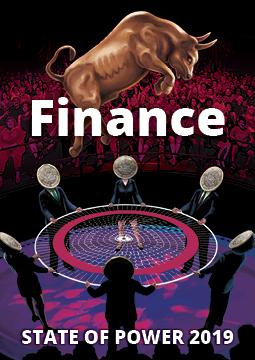Photo: Tatiana Fet from Pexels
State of Power 2019: seeing finance in order to confront it
- February 3, 2019
Capitalism & Crisis
Exposing finance will enable us to disrupt established power dynamics and imagine a reconfigured global system designed to serve humanity rather than business.
- Author
We live in a world where the most important things are not seen. We do not see — or rarely see in the public eye — the vast numbers of people who lose their homes in a financial crisis. But neither do we see the financial engineers who created the algorithms behind the toxic derivatives that made those people homeless. Power has always operated thus — where the powerless and the most powerful are largely invisible. And where the systems of power are so hidden that media and politicians barely acknowledge them.
The financial sector, though, must qualify as the most invisible of today’s corporate power centers. Obscured by a technical language that few understand, making unfathomable amounts of money in inexplicable ways, operating algorithms that even banking executives can’t explain, the financial sector is today’s Enigma code. It’s not surprising that social movements have often focused their attention elsewhere, targeting corporations and politicians whose crimes are more visible or obvious. The Occupy movement broke with this tendency, but was an exception to the norm.
The tenth anniversary of the global financial crisis seems like a good moment to turn a spotlight on the financial sector. For a number of years, the Transnational Institute has produced an annual State of Power report, because we believe that all struggles for justice and systemic change ultimately have to grapple with the question of power — who has it, how it is used, how we confront and dismantle unjust power structures, what counterpower looks like.
In the area of finance, we can see that despite a catastrophic role in causing the financial crisis that should have permanently challenged the very legitimacy of capitalism, the banking and finance sector has not been weakened but emerged even stronger than ever before. Popular outrage at the financial sector’s excesses failed to match their power. And the frustrations that have resulted have been channeled in many cases into nationalist, xenophobic ends rather than in weakening the pillars of financial and corporate control. How did this happen? What options are there for regaining popular control of money and finance?
To answer these questions, TNI commissioned prominent thinkers, activists and artists — and also put out an open call — to explore dimensions of financial power and suggest ways we might rein in the banks. The full report, including some great infographics, can be seen here. As part of our new partnership with ROAR we are featuring three of its core essays and one interview that in different ways make financial power visible and therefore open to our challenge and demands for systemic change.
In Offshore Finance: How Capital Rules the World, Reijer Hendrikse and Rodrigo Fernandez penetrate to a core logic of capital embodied in offshore finance, made famous in recent years by the Panama Papers and LuxLeaks. They show how ultimately it is not simply about corrupt businessmen secreting money away in exotic islands, but rather concerns sovereignty and power.
Hendrikse and Fernandez argue that offshore finance is the “central operating system” for capitalism. Their analysis helps us see that what is being constructed is a global order of two-tier sovereignty, “in which ordinary citizens and businesses are subject to global capitalist rule via their respective states — enforcing austerity, taxes and, increasingly, authoritarianism,” while “offshore residents” are unbound by “territorial enclosure, having effectively become a global ‘stateless’ oligarchy, living secretive and tax-free lives with their vast fortunes supported by expansionary monetary policy.”
Hendrikse and Fernandez draw analogies with Susan Collins’ Hunger Games, where citizens pay tribute and sacrifice lives to an offshore oligarchic “Capitol.” They argue that the offshore world “offers a narrow political target to mobilize a broad political base, one that can bring together the indignant and deplorable, uniting red squares, green ambitions and yellow vests.”
In Art, Capital of the 21st Century, artist and curator Aude Launay takes a different path of exposing finance, showing that its very abstraction has provided a rich ground for artists to expose financial manipulation. Art, of course, has itself been financialized, but Launay shares compelling examples of artists who have produced artwork that helps render those processes visible.
She cites one trader, James Grubb, who in a series of trades of a particular company’s stock produced an image of a middle finger — and contributed towards the company’s de-listing. Another, Femke Herregraven, visits De Zuidas, Amsterdam’s business district, where many corporations exist only as mailboxes for tax-avoidance and trade treaty protection purposes. She has turned their names into a company directory titled Geographies of Avoidance, as well as an interactive video game.
These interventions have not just unmasked financialization, they have also provoked conversation and reaction. The creation of an an alternative credit-rating agency by Cassie Thornton in San Francisco helped her subjects challenge processes of gentrification. Her credit reports based on real-life stories may have been fake in the financial world, but “what worked was that their conversation empowered them and made them look more confident when they met potential landlords. Here again, the value of the artwork lies not in the object itself but in the network, even more so if we take the word value in the sense of an intrinsic quality.”
In the interview with three activists in Battling Bankers, it is clear that there was a moment in all their struggles where the role of the financial sector became clearly defined, visible. A moment when the fuzzy opaque arcane exterior shattered to reveal the naked exercise of power and capital. For Simona Levi of 15MPaRato, it was the image of one graph showing that half of the government’s bailout money, 5 billion euros, was going to one bank.
Her outrage at this state largesse at a time of acute unemployment and poverty led to an unprecedented legal action and has resulted in the imprisonment of 17 bankers in Spain, including the former director of the IMF. Her campaign did not arise because she saw evidence of crimes, but started from a mere conviction. Combined with creative media work and popular mobilization, that determination led to crucial evidence coming to light through a series of leaks.
Similarly it is noticeable that Joel Benjamin, involved in the hard work of examining and challenging toxic loans to city councils in the UK, had no experience or knowledge of finance. Yet it didn’t take long for him and Debt Resistant UK to start to unravel trails of abuse and exploitation, even if bankers tried to hide it in spreadsheet columns named “Other.” His experience showed that people in the one of Britain’s poorest boroughs, Newham, quickly understood financialization’s fundamental dynamics when they saw its impacts on local services.
As Saskia Sassen makes clear in an interview for State of Power, finance may be highly digitalized and abstract, but it also “has a strong material presence and nowhere more so than in the city.” It is physically present, in banking buildings, in warehouses housing computers, in the main auxiliary legal, accounting and other services that underpin its activities. This physical presence provides ample targets for taking on the banks.
The campaigns of 15MPaRato, Debt Resistance UK and Tax Justice Africa that have imprisoned bankers and stopped tax treaties show that it is possible to see finance and confront it. Rather like the Wizard of Oz, the financial sector’s opaqueness and attempts to hide itself behind a curtain of special effects are a sign ultimately of weakness rather than strength. Understanding that we can see and understand much more of how finance operates than we realize is critical to challenging their power.
That, of course, does not mean that confronting global finance will be easy, given the way it has taken over our entire political system. However, it will enable us, in the words of Alvin Mosioma of Tax Justice Africa, to “disrupt the power dynamics that inform policy direction,” to “change the narrative and imagine a reconfigured global system designed to serve humanity rather than business.”
Read the full State of Power 2019 report here.
Source URL — https://roarmag.org/essays/state-power-2019-seeing-finance-order-confront/
Further reading
The gentrification of payments
- Brett Scott
- February 4, 2019



